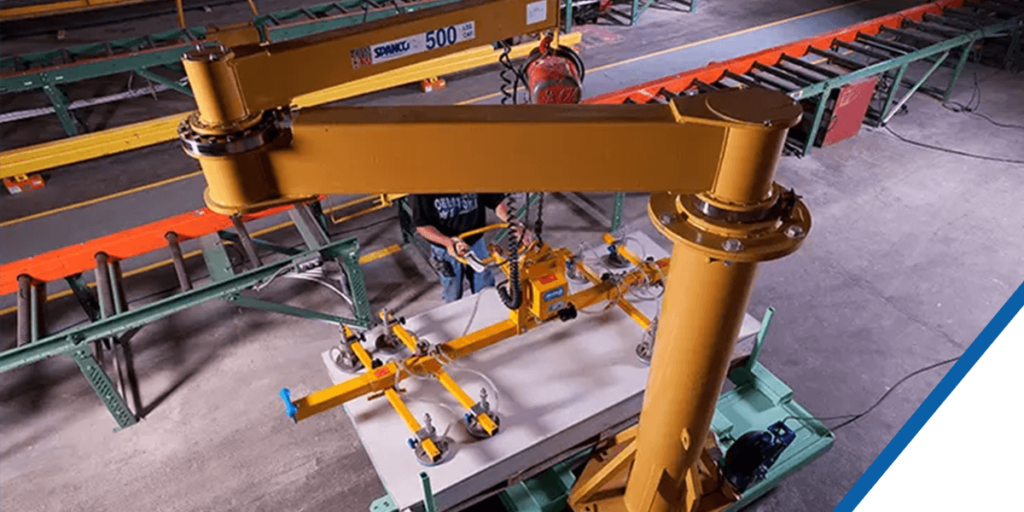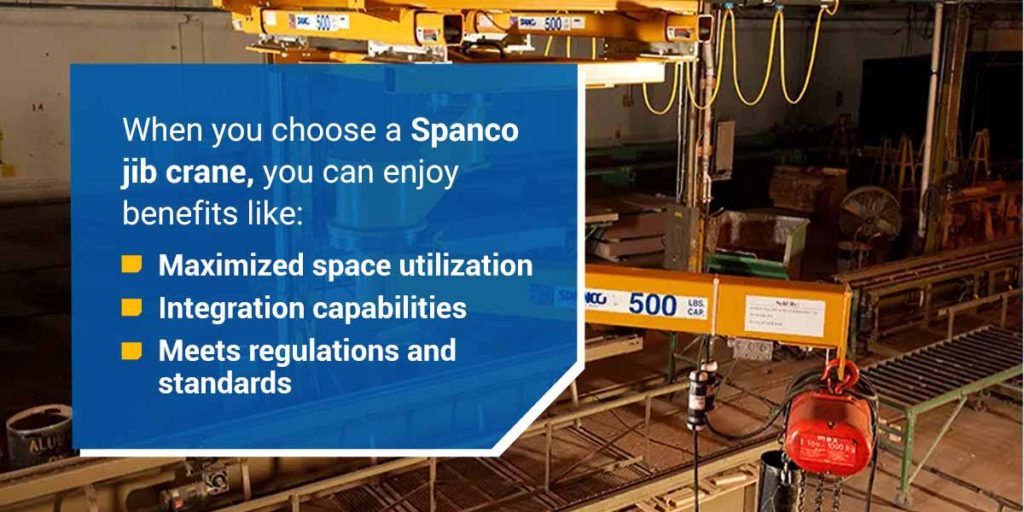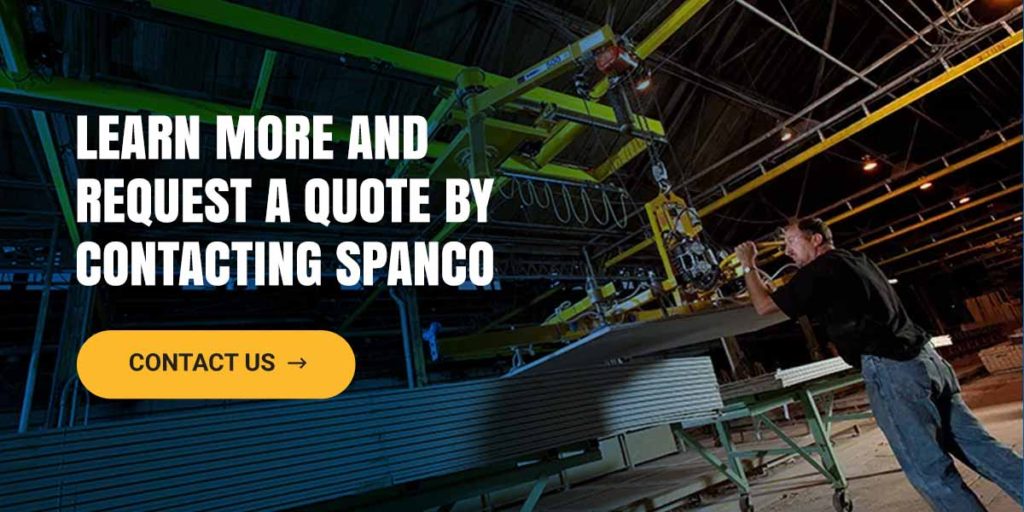
Uses and Applications of Jib Cranes
May 1, 2023
Cranes are versatile tools found in many industrial applications. This equipment allows you to lift, lower or move objects horizontally. Teams can move heavy loads safely and help complete projects efficiently.
One type of crane is a jib crane. This type features a long horizontal beam called a boom that rotates around a fixed point. Jib cranes are extremely adaptable and able to meet a variety of load types and weights. They’re most commonly found in tight workspaces.
Learn more about jib cranes and how Spanco jib cranes can benefit you.
What Are Jib Cranes and How Are They Used?
Jib cranes are lifting devices with an arm that extends horizontally off the main body. The arms, called jibs, allow the crane to reach further and manage a wide range of loads. The working principle of jib cranes is based on arc-like or lateral movements, allowing for flexible transport.
Jib cranes are used for various industrial applications. For instance, qualified personnel can place them on warehouse floors and use them to lift goods to higher positions. They’re frequently found in smaller work areas or used for repetitive tasks. Because the cranes are highly adaptable, you can apply them in many settings.
Common applications of jib cranes include:
- Shipping: You can use jib cranes to load and unload materials on and off ships and trucks. Large and heavy-duty jib cranes can efficiently load a wide range of products.
- Construction: Jib cranes are particularly useful in construction applications because you can move loads into hard-to-reach locations.
- Warehousing: Warehouses often use jib cranes to handle materials and move them through inventory. Many jib cranes have precise capabilities to place them on production lines or other specific areas.
Jib Crane Parts and Components
While jib cranes can vary depending on the type, they typically feature these basic components and parts:
- The boom: The boom is the horizontal beam that moves on the crane, rotating around a fixed point. It extends from the central mast and runs perpendicular to the ground. The reach also contains the hoist that moves and lifts the load. Depending on the crane design, the beam can move between 180 and 360 degrees.
- Mast: The mast is the vertical beam where all the other components rest. It usually consists of high-strength steel and is highly durable. A mast is secured to the floor or walls of a building for use, providing support for the boom and other essential features.
- Hoist: The hoist attaches to the reach and powers the lifting for the jib crane. Many types are available, depending on load types and weights. They vary by material type and power source. Hoists can consist of wire ropes, chains, or levers, and their power source can be manual, pneumatic, or electric. You can choose the type that suits your lifting requirements. For example, operators often use chain hoists for lighter loads, while wire rope hoists better suit heavy-duty weights and applications.
- Trolley: Jib crane trolleys are designed to hold and facilitate the boom’s weight as it moves. Trolleys remain in an immovable position while the hoists raise the load.
- Festoon systems: The festoon system carries cables and power to the trolley and the boom. Festoon systems make power cables safer and easier to control. They can consist of different configurations depending on the crane type. Most commonly, festoon systems are in systems with longer booms.
- Power source: Jib cranes can use electrical, pneumatic, or power lines to gain power. Some jib crane types have push-button controls to power the crane’s motion. A crane operator uses the power source to control the lift without having to stand directly in the load path.
Types of Jib Cranes
Jibs are versatile devices that can suit different lifting applications. Your facility can select a jib crane type that meets your load capacity and environment:
- Freestanding: Freestanding jib cranes are a popular choice for many applications. You can use them in both indoor and outdoor locations and have a wide capacity reach. Freestanding cranes can either be mounted to a base plate, on a secure foundation like a steel plate, or into a sleeve insert.
- Wall traveling: A wall traveling jib crane moves along rails attached to the walls. You can move the crane to all areas of the building, making it easy to transport loads in short time amounts. You can also add wall-traveling cranes onto overhead cranes to create a comprehensive lifting solution.
- Wall-mounted: Wall-mounted jib cranes don’t require any floor or foundation space. When they’re not in use, you can fold them against the wall to prevent obstructions. Wall-mounted jibs range in weight capacities and types. For example, you can select between a cantilever design and a tie-rod-supported structure.
- Mast type: A mast jib crane is supported by the floor and the ceiling top. Ceiling beams stabilize the jib cranes in place. They take up little floor space and don’t require you to alter foundations or ceilings to accommodate them.

Advantages of Spanco Jib Cranes
Spanco has been a leading provider of material handling solutions for over four decades. We manufacture a range of jib cranes that can suit a variety of applications and environments. Certified engineers can customize our jib cranes to create a personalized solution for your project.
When you choose a Spanco jib crane, you can enjoy benefits like:
- Maximized space utilization: We carry wall-mounted, ceiling-mounted, and wall-traveling jib cranes that take up little or no floor space. Other options fold against the wall, allowing you to use maximum floor capacity. You can quickly fold them up and out of the way for an overhead crane or other tools.
- Integration capabilities: Some designs allow you to integrate the jib crane into existing columns or beams. You can avoid rearrangement or redesign expenses by easily moving the crane into your environment.
- Meets regulations and standards: All of our manufactured cranes meet OSHA, MMA, CMAA, and ANSI standards, making them ultimately secure and durable for use.
Visit Our System Selector to Find the Perfect System for Your Facility
Spanco offers a wide range of material handling systems, including gantry cranes, bridge cranes, and jib cranes. If you need a new system but aren’t sure which is the best fit, use our system selector today. The interactive tool guides you through all Spanco options and recommends the best system for you. You can answer questions based on:
- System type
- Travel method
- Height under the beam
- Weight capacity
Once the tool selects your optimal fit, it recommends Spanco options for you to order.

Learn More and Request a Quote by Contacting Spanco
At Spanco, we’re committed to finding customers the best material handling solution. Whether you’re seeking a jib crane or anything in between, our team can help you find the ideal system for your project specifications.
To get started with Spanco, contact us today.
Categories
Share this post
Contact us
Looking for the perfect fall protection equipment? Let us help!
